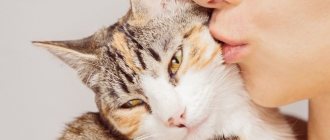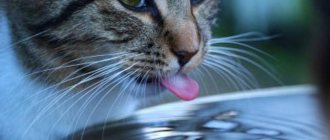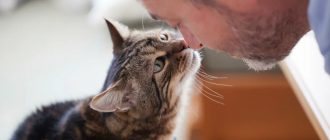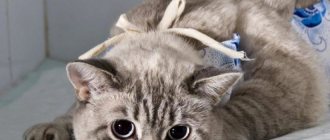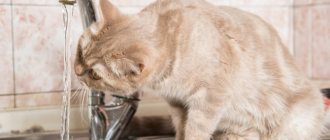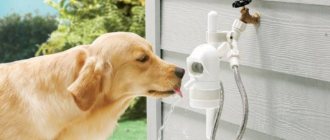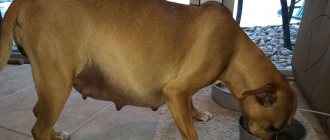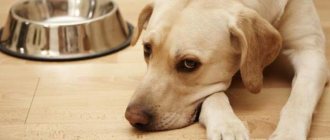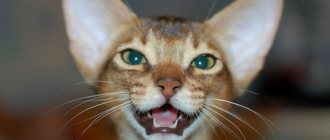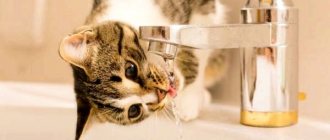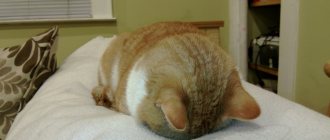How much water should a cat drink per day?
Cats drink as much as they need. According to statistics, the daily norm should be from 20 to 40 mg per 1 kg of body. If your cat weighs 5 kg, she should drink up to 100 ml of liquid per day. Pregnant and breastfeeding women should drink twice as much. Breastfed kittens do not need water at all. They receive their daily fluid intake from their mother's milk.
A cat's body is made up of 70% liquid.
The given amount should not be considered as something that a pet must necessarily drink daily. Consumption depends on the following points:
- age, weight and breed of the cat;
- time of year and room temperature;
- type of feed;
- convenience of drinking bowl.
If the cat is on dry food, liquid intake should be two or three times the amount eaten. For example, if an animal eats 50 g of food, then it should drink from 140 to 180 g of water, depending on its weight. Canned food contains about 80% liquid. To quench your thirst, 100 g of water will be enough for your cat.
Important! Even if the kitten has eaten soup or drank kefir, clean water must be present, otherwise it will not receive the necessary minerals.
Increased thirst over several days is a reason to consult a veterinarian
What kind of water should I drink?
To avoid health problems, it is not enough for an animal to consume a certain amount of liquid per day. Another important condition is that the water must be of high quality, which is why the owner needs to be very careful about its choice. For an animal to like water, it must be:
- fresh and clean (it is recommended to change the water every day);
- do not contain foreign odors;
- should be freely available.
If owners give their pet water from the tap, before pouring it into a bowl, the liquid must be filtered and allowed to steep for at least 5 hours. However, veterinarians categorically do not recommend using it, since running water contains many harmful impurities and components, including chlorine.
Reasons for refusal
The kitten does not drink water - options for how to train your pet
Pets drink water in small quantities. If the bowl remains untouched, the reasons may be as follows:
- The cat doesn't drink water because it's not trained. After weaning from breast milk, the kitten does not know how to drink water. To accustom a cub to water, you need to place a bowl of liquid next to it, wet your finger and wipe the kitten’s mouth and nose. The baby will develop a licking reflex, thus taming him to drink;
- dirty dishes and feeding area. Pets are clean by nature, so it is necessary to keep the feeding area and water bowl clean. Twice a day it is necessary to pour boiling water over the drinking bowl and food saucer. The drinking bowl should be located separately from the food so that crumbs do not get into the drink;
- incorrectly selected bowl. When choosing dishes, you should consider the breed of the cat. For British or Persian, a shallow bowl will do. The material you should use is a ceramic drinking bowl. Plastic can emit an unpleasant odor, and cats are very sensitive to them;
- feeding features. The pet refuses water if it eats wet food;
- outside source. Cats often drink water from the bathroom tap, toilet, sink, or aquarium. The owner of a four-legged animal should interest the pet and try to create the same environment. You can replace the aquarium with a saucepan, and you can use a fountain to imitate a stream;
- proximity of the bowl to the toilet, washing powders and other detergents. Water can easily absorb odors from detergents. An animal may refuse to drink near the place where its tray is;
- health status. Fluid refusal can be associated with various diseases;
- sterilization of a pet can provoke a refusal to drink for 12 hours;
- childbirth. Drinking after childbirth decreases. After the natural process, the cat must be given something to drink after 2-3 hours. After prolonged labor and caesarean section, the fluid is given intravenously.
A kitten must have at least two bowls
When is it normal to refuse water?
If the animal is on a natural diet, refusing water should not cause concern. When a cat eats meat, vegetables and other natural foods, its body receives a sufficient amount of fluid from food, so it does not need water.
In addition, animals that “walk on their own” may not drink water at home, but get it from the street. Often domestic cats are fed from neighbors, where they can get water. Cats that eat dry food at home can periodically go outside to hunt. A caught and eaten pigeon, sparrow or mouse completely covers the body's need for fluid.
Conclusion: if the owner does not see the cat drinking water, this does not always mean that the cat is not drinking. In the case of natural food in a pet’s diet, a complete refusal of water is the norm.
What are the dangers of dehydration in a cat?
Recently, furry pets are increasingly suffering from dehydration. Lack of fluid in the body leads to irreversible consequences. A cat may stop drinking water as a result of kidney failure or diabetes. Pets can suffer from dehydration due to an eating disorder. A change in the amount of drinking water intake leads to disruption of metabolic processes.
The dog does not drink water but eats: reasons for how to get a puppy to drink
The main causes of dehydration include:
- change in body temperature;
- prolonged diarrhea and vomiting;
- loss of fluid due to frequent urination;
- lack of drinking bowl;
- heatstroke;
- loss of large amounts of blood;
- fever;
- poisoning;
- staying in a state of shock and stress for a long time;
- infections, viruses, chronic diseases.
Note! Often, large amounts of water are lost during diarrhea. If your cat is diarrhea all day long, she already has some degree of dehydration.
There are three stages of dehydration:
- light. The symptoms are practically unnoticeable; the animal’s nose will be slightly warm;
- average. Sticky and viscous saliva. Dry and pale gums;
- heavy. The cat does not eat, she has lost a lot of weight. She has tachycardia and weak heartbeat, and a dry nose.
Why doesn't the cat drink water?
In fact, it’s not so scary if the cat drinks little water. This means that there is enough moisture in the food to satisfy the need.
It’s not so scary if the cat drinks little water.
In addition, many breeds generally come from desert areas, and in the desert, as you know, there is practically no water. Normal physiological water consumption is considered if a cat weighing up to about four kilograms drinks half a regular glass of liquid. Water is necessary for the body for the normal functioning of all body systems.
Is it harmful?
The liquid has the ability to promote normal metabolism, remove toxic substances and waste from the body.
It is also part of every single cell of the animal’s body. Thus, we can conclude that a cat simply needs water, and dehydration is fraught with many serious problems. Most pets who drink little suffer from urolithiasis. If at the same time the diet of such an animal is not properly balanced, then stones in the bladder or kidneys are guaranteed.
The cat needs water!
There are a number of negative consequences that result from minimally hydrating food:
- as a result of dehydration, the inability to form urea;
- the minimal amount of remaining urine becomes highly concentrated and becomes toxic;
- precipitation of salts;
- formation of stones from precipitation.
When cleaning the cat's litter box, yellowish crusts , which are very difficult to wash off.
This is nothing more than salt deposits and the same ones are found in the renal pelvis. To avoid this, the animal simply needs to drink enough fluid.
Methods for determining the amount of water you drink per day
The cat does not eat or drink after sterilization
To understand whether a cat drinks enough per day, just pull it by the withers. If the animal is healthy, then the withers immediately returns to its original place. When dehydrated, the tubercle remains in place for some time.
The less a cat drinks fluids, the less elastic its skin
Step-by-step instruction:
- Carefully grab the skin above the shoulder blades.
- Pull it up and down.
- Normally, it should immediately return to its place.
Kittens under eight months of age have rougher skin than older cats and will take longer to recover.
You also need to pay attention to how often your cat urinates. If she goes to the litter box at least 2-3 times a day, then this is a sign of normality. This can be easily checked by the condition of the tray.
You can do one of the old tests: open your pet's mouth slightly and lightly press on the gums. If it acquires a light shade and does not change color within three seconds, this indicates illness.
Important! If the mucous membrane is light, saliva is viscous and weakly secreted, this may indicate pathology.
You can check for dehydration by looking at your eyes. Deeply sunken ones indicate that the cat is not drinking enough fluids. In a healthy animal, the eyes appear slightly sunken. With age, or in thin or chronically ill pets, sunken eyes are normal.
Note! Cold paws indicate severe dehydration.
The main symptoms also include:
- dry skin;
- lethargy;
- apathy;
- poor appetite;
- sunken eyes;
- constipation or diarrhea;
- arrhythmia;
- poor sleep;
- weight loss;
- saliva viscosity;
- pale gums.
Important! If at least one sign is detected, it is necessary to immediately begin procedures to restore water balance.
Cat refuses water after sterilization
After the operation, the animal recovers from anesthesia and does not eat or drink anything for the first day. On the second day, they begin to feed the pet a little. To prevent the cat from straining and the stitches from coming apart, they give watery food: it is more profitable to take dry food for sterilized cats and dilute it to a liquid state.
You will have to forget about natural nutrition, otherwise the cat will be at risk for obesity and urolithiasis. In this state, the pet will not lap until it is switched to a dry type of food.
What measures should be taken if the cat does not drink water at all?
The cat drinks little water, what should I do? If dehydration is detected, it is necessary to forcefully inject water using a syringe, you can add sugar. In this case, the cat may experience a gag reflex, in which case it is necessary to inject a solution of sodium chloride or glucose. Additionally, you can inject the kitten with 1 mg of Gamavit. These manipulations will save him from loss of vitamins and minerals.
For your information! Losing important elements, the pet loses weight, stops eating, sleeps constantly, and cannot sit or walk. Subsequently, he may fall into a coma and die. If severe dehydration occurs, you should go to the clinic, where your pet will be given the required amount of fluid using a drip.
To make a diagnosis, the veterinarian prescribes general and biochemical blood tests. With insufficient fluid intake, red cells in the blood increase, protein is higher than normal, and hyperconcentration of urine occurs.
If the animal is suffering and refuses water, it is necessary to give the pet the following medications for a week:
- for the vascular and cardiac system. When dehydrated, the blood becomes thicker, the heart pumps blood poorly, it is necessary to give caffeine or cordiamine;
- To suppress the gag reflex, the pet is given cerucal subcutaneously.
Injections cause additional stress. Before the procedure, you need to sit next to the cat and pet it. Then stretch the skin around the withers with your fingers, pull it back and carefully guide the injection syringe. The needle should not be inserted from top to bottom, but horizontally to the animal’s spine. The medicine must be injected slowly, and then the needle must be quickly pulled out.
The needle is inserted along the animal's body
After visiting a doctor, you should take the following measures to restore your drinking regime:
- The drinking bowl and food bowl must be placed far from each other. Wild cats did not drink water near the place where their dead prey was located. This instinct is also inherent in domestic cats;
- you need to change the water often. It must be constantly fresh;
- If your cat doesn’t like regular bowls, you can purchase a special fountain. It will appeal to those pets who like to drink from the tap;
- You can attract the cat's attention with an ice cube. Ice thrown into the water will attract the kitten, he will try to pull it out, and thereby drink water;
- some owners recommend adding a pinch of soda to your drink;
- To prevent your cat from refusing water, you can add a little milk or broth. Pets like their smell. Such water should be changed more often, it quickly deteriorates.
The water in the fountain is always fresh and oxygenated
Note! Neutered pets recover in about a day. During this period, it is necessary to forcefully water the animal. After the cat recovers from anesthesia, it is necessary to monitor the condition of the mucous membranes so that the eyes and nose remain moist.
How to teach a kitten to drink?
There are many ways to teach a kitten to drink water from a bowl. The easiest way to do this is during an active pastime. During the game, the pet moves a lot and loses more moisture than in a calm state. Immediately after the game, the owner needs to bring a bowl to his face, so the chance of teaching the animal to drink cool water increases several times.
If the animal still refuses to drink, it can be forced to do so, for example, using a syringe filled with water. In addition, a small amount of liquid can be added to your pet's food so that he consumes it along with food. If the cat is very small, you can teach him to drink in the following ways:
- You can add a little milk to the food and gradually mix it with water. Kittens know what milk smells like and therefore rarely refuse it.
- You can place several bowls filled with clean water throughout the apartment. They should attract the kitten's attention, so it will be much easier to teach him to drink.
- Another effective way to teach a kitten to drink is by wetting its nose in water or milk. The owner just needs to wet his finger in water and wipe the animal’s nose with it several times. The cat will lick it by inertia, thereby getting used to the smell and taste of water.
If your pet is used to drinking from a tap and likes the sound of running water, you can purchase a special drinking fountain and install it in a convenient place.
Drinking fountain
On a note! It is strictly not recommended to place a bowl of water near a cup of food. This is due to the fact that the water must be perfectly clean and free of foreign odors, otherwise the animal may continue to refuse to drink.
Features of water consumption by a cat
You can often observe the process of a cat drinking water with its paw, so the question arises as to why it does this. The thing is that these creatures cannot determine the surface of the water when it is in a calm state. Therefore, so that their nose does not scoop up the liquid when it is in it, it is easier for them to drink water from their paw. After a certain time, the cat will learn to “see” the surface of the water with the help of its paw, tongue or whiskers and will drink the liquid, as is customary to do.
To help her, you can purchase a special container for drinking cats, which also contains a filter for additional purification of water from harmful elements for the animal’s body.
You can give your cat water using a syringe.
As mentioned above, cats generally drink very little water or do not drink it at all. There are a number of reasons why they behave this way. However, you should always remember about the purity of the water, which should contain all the microelements necessary for the normal development of the animal, and it should not wash away calcium and potassium from the body. Therefore, distilled water should be discarded, since it will not bring anything useful to the cat.
Knowing the full range of reasons why a cat refuses to drink water, you can eliminate them and return the animal to a normal lifestyle.
How to determine if your cat drinks enough fluid per day
Animals have the same problems as humans when they don't get enough fluids. Cats may not get the moisture they need for a variety of reasons, but owners should closely monitor their pet's health.
Be sure to read:
What to do if a cat marks in the apartment, how to deal with it
The following signs may indicate your pet's condition:
- Skin elasticity . Your pet's skin becomes dry and stiff if he doesn't drink enough fluids. Normal dermis quickly regains its shape if you grab the cat's scruff and pull.
- Condition of the coat. It is worth sounding the alarm when the cat’s fur loses its shine and begins to fall out. If the animal does not have parasites or allergies to the selected diet, then the problem may lie precisely in the lack of moisture. When a pet's coat is shiny, it makes it clear that its health is not in danger.
- Physical activity. Without the necessary moisture, the cat becomes inactive, reacts sluggishly to calls, and does not want to play.
- Frequency of urination . If an animal urinates less than 2 times a day, this is a sign of ill health.
How to tell if your cat is not drinking enough water
An acute lack of fluid in the body at the cellular level leads to the fact that the cellular structures shrink, the blood and lymph circulating throughout the body become much thicker. Oxygen does not penetrate the cells in the required quantity, oxygen starvation occurs. Against the background of dehydration and serious disorders, pathological changes occur in the intestinal tract, ureter, and respiratory tract. The pet becomes lethargic, the coat becomes dull, and the animal’s state is apathetic.
It is necessary to understand that young animals in good health can be without drinking water for a long time - for 3-4 days. The older the animal is or has a history of a number of chronic diseases, the higher the risk of pathological changes when dehydration occurs. The body's reserves are depleted, which provokes severe problems, which ultimately leads to death.
Unlike dogs, cats are not particularly fond of drinking water, especially in large quantities. However, their need for clean drinking water is significant. Cats need much less fluid per day than dogs or other animals, but without water the body cannot function normally.
As a result of the fact that water is an important component of both cellular structures and intercellular space, the biological properties and structures of elements are determined, influencing the process of thermoregulation of the body and the transfer of useful components.
Regular loss of fluid occurs in the body along with salivary fluid, urine and feces. In the absence of replenishment, serious complications arise that provoke problems in the functioning of the entire body.
If a cat refuses to drink on its own, the risk of dehydration increases. Against the background of dehydration of the whole body, internal organs begin to suffer, and first of all, the central brain. All metabolic processes in cells are disrupted.
Scientists have proven that with a percentage loss of body fluid of up to 10%, there is a high risk of developing irreversible processes in the tissue structures of the body. If the percentage of fluid loss exceeds 15-20%, the animal may die. Dangerous conditions that lead to a sharp development of dehydration are stool disorders (profuse diarrhea), persistent vomiting, extensive hemorrhages (especially internal bleeding) against the background of injuries to internal organs, edematous conditions. In addition to fluid, the body loses a large amount of microelements, vitamins and other nutrients.
Such conditions and changes in the body are difficult to normalize. As soon as the owner notices a problem in the pet’s health, it is recommended to immediately contact a veterinary clinic for help. Only in a hospital hospital setting is it possible to carry out infusions of saline solutions, glucose or other substances that maintain the body’s water balance at the required level, avoiding the development of complications.
